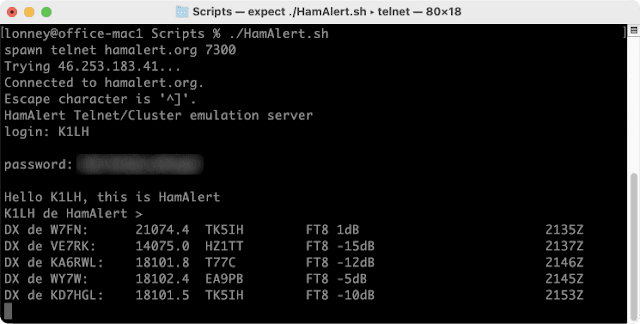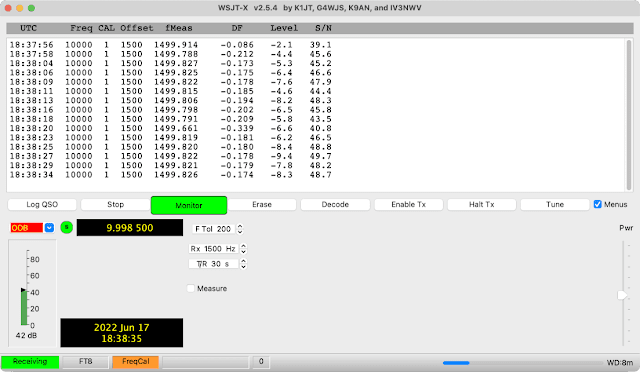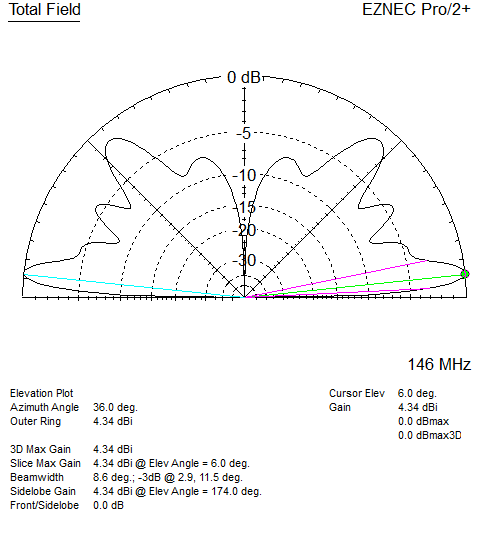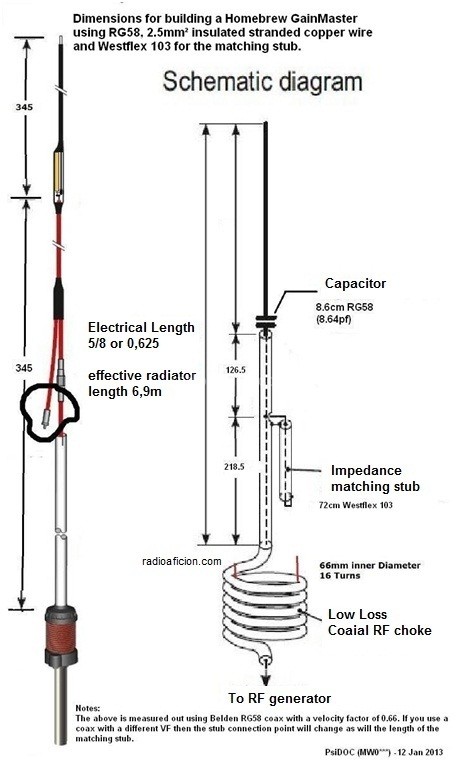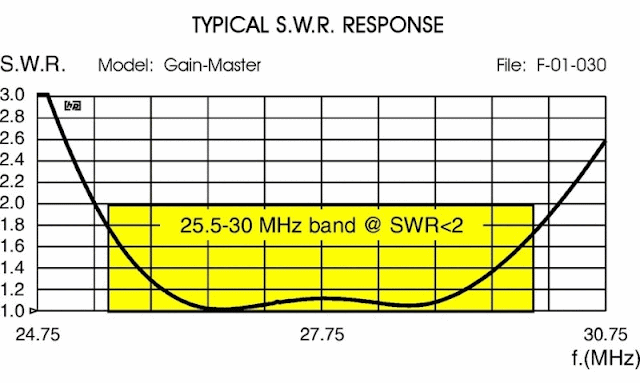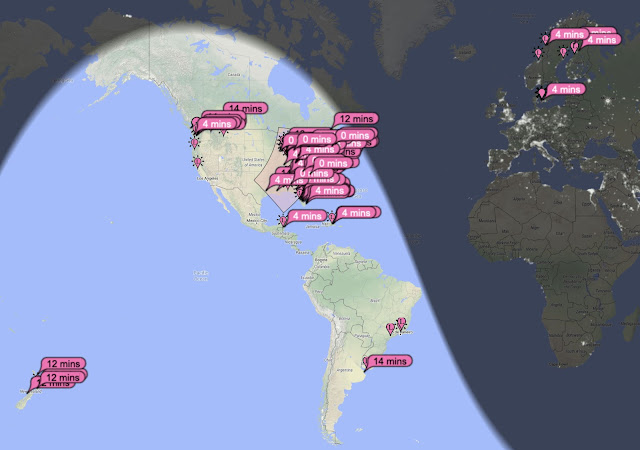With a 6m Yagi and weak signal digital mode Q65-A it's possible to receive EME (Earth Moon Earth) signals during moonrise or moonset.
Q65 can also be used for terrestrial contacts where other weak signal modes such as FT8 may not succeed.
It's also possible to do "QRP EME" on 2m and 70cm, see QRP EME - An incomplete Guide (KG5CCI).
Note: Unlike on FT8, WSJT-X wont make use of Split fake it/rig to keep the TX audio in the middle of the filters, if you get too far away from 1500 Hz power output will start to drop off.
More info
Configuring WSJT-X for Q65 and 6m terrestrial
Mode > Q65
6m > 50.275 MHz
File > Settings > Enable VHF and sub-mode features (not sure that is required)
File > Settings > Decode after EME delay - only used for EME, leave unchecked for terrestrial - though I’ve had this checked and its worked ok.
Decode > Fast for terrestrial (remember to set this back to normal or deep for FT8 and other modes). Enable averaging, and Auto clear AVG after decode on.
Terrestrial: On the main WSJT-X screen set the offset to 1500 Hz, F Tol to 100 or 200, Submode A, T/R 15 or 30 - these last two settings indicate the mode, e.g. Q65-15A, Q65-30A.
Once a QSO starts change F Tol to 100, 50, or 20.
WSJT-X Wide Graph has a Q65_Sync setting.
https://wsjtx.groups.io/g/main/topic/83263895 that post has a lot of info about terrestrial Q65. Suggests that using 15s T/R for Q65-15A is very close in performance to 30A, and twice as fast. Also covers other sub-mode combinations and QRP use.
In practice 30-A on 6m seems to be the most commonly used Q65 submode.
Here is a more recent QSO on 6m Q65-30A with W7OUU who is 500 mi / 800 km south east of me in Idaho, the band was otherwise closed with no FT8 activity.
They were running 1.1 kW with 7 elements, I was running 85 watts with 3 elements. This QSO took around 45 minutes to complete, and 15 minutes before I got the first decode (Q65 averaging at work):
I was able to reliably decode them on nearly every cycle after the first decode, with my much lower power output and lower gain antenna it took some time for them to decode my messages, but we got there in the end, and DN22 is a new grid on 6m for me too!
I've since worked W7OUU again, and WB7UNU in Spokane 200 miles east for another new grid with the band was otherwise closed.
Final thought: Since Q65 uses averaging to build confidence in subsequent decodes, and can take advantage of any propagation mode (tropo, aircraft scatter, meteor scatter, etc), this QSO may have used a combination of these to complete with enough "fragments" eventually making it though for a successful decode.
Auroral Propagation
With a recent Auroral opening (23-Mar-2023) on 6m was the first time I'd experienced this. On SSB and CW the signals were quite distorted which is normal, but they are readable.
It was then suggested to try Q65-30C or Q65-15B (same tone spacing, half the time). Listening to the tones with the volume up they sounded distorted, and yet it worked reliably. I was able to complete a couple of QSOs quite easily with good decodes on each sequence, and one on SSB:
This was quite a nice surprise, as the distorted FT8 signals I heard did not decode. Q65 certainly seems to be the magic mode for the magic band!
Earth Moon Earth
My interest in EME starts in the mid 90s when I was a freshly minted new ham, friend and I got invited (likely we invited our selves) to see Paul ZL1PE's 2m EME setup. Back then it was CW only (no digital modes existed then for EME, or much else).
Paul had built an H stack of four long boom 2m Yagi's with elevation and azimuth rotator, home brewed an amplifier using something along the lines of a 3CX1000 (I forget exactly), high gain masthead pre-amp and high powered coaxial relays, the feedline was hardline. Amazing stuff to see, and a lot of effort for a propagation mode where you could only use CW when the moon was up.
With the advent of digital modes and home computers faster than we could imagine 30 years ago and now take for granted, the barrier to entry for EME is much much lower.
Much thanks to Bob ZL1RS for most of the EME information.
Where is the moon?
Find when and where the moon is with something like https://www.timeanddate.com/moon/
Antennas, ground gain
With a Yagi pointed at the horizon (a regular horizontal Yagi installation) the added advantage of ground gain can be made use of during moonrise and moonset.
Antenna height, higher not always better! Consider these two 4NEC2 plots of 7 element Yagis at different heights, one at 7 meters / 23 feet vs 18 meters / 60 feet:
 |
| Plot by Bob ZL1RS |
Red is the Yagi at 7 meters, it has one broad lobe that will cover between the horizon and about 15 to 20 degrees elevation. The same antenna at 18 meters, has 3 lobes, the moon will pass through each of those much quicker and be "lost" in the nulls.
Assessing the local noise floor for EME
Test 1 - Disconnect the antenna and with WSJT-X note the noise floor with the dB meter bottom left. If there is a difference of more than 10 dB when connected, the local noise floor might be too high.
Test 2 - Preamps - With antenna aimed at moonrise/set direction, turn preamp(s) on and AGC to fastest setting. If any signal level is registered on the S meter (indicating AGC action in the receiver) the local noise floor might be too high.
For me living in city my local noise floor is too high based on the second test as I get AGC action in the receiver. I'd need use to higher gain Yagi(s) with elevation rotators to get away from the noise sources when the moon is (much) higher in the sky.
Configuring WSJT-X for Q65 and 6m EME
Mode > Q65
File > Settings > Enable VHF and sub-mode features (not sure that is required)
File > Settings > Decode after EME delay (that one is important)
Decode > Deep (some say fast is more sensitive). Enable averaging, and Auto clear AVG after decode on
On the main WSJT-X screen set the offset to 1500 Hz, F Tol to 100 or 200, Submode A, T/R 60 (these last two settings indicate the mode, e.g. Q65-60A).
WSJT-X Wide Graph has a Q65_Sync setting.
Frequencies, where to find others on EME
Most EME activity is in the 50.180 to 50.210 area with 50.188 to 50.208 being most popular for sked arrangements. You wont find it tuning around.
A DT of 2.5 seconds indicates EME, DT of 0.0 or 0.1 indicates terrestrial propagation modes.
ON4KST runs an online chat service (runs in browser), goto http://www.on4kst.info/chat/start.php and choose EME all bands/mode, this is where coordination between stations happens.
HB9Q EME Logger is another.
Transmitter Power with EME
Receiving Q65 via EME is the first step, transmitting typically power levels around 1 kW are used.

